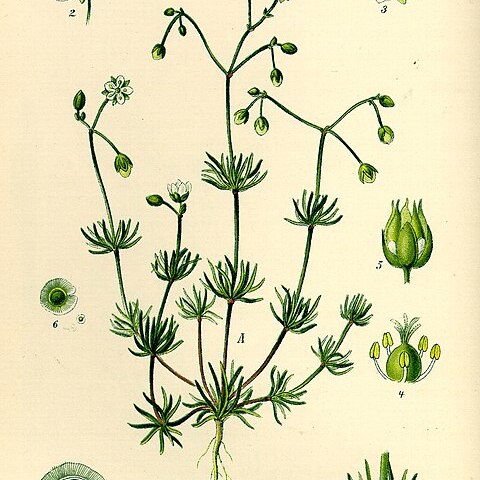Herbs annual, rarely perennial, much branched at base. Stems ascending, often decumbent. Leaves opposite, usually apparently verticillate with leaf-fascicles (short, leafy, lateral branches) on both sides of nodes, sessile; leaf blade linear, fleshy; stipules free, scarious. Inflorescence a cyme, terminal. Flowers 5-merous. Pedicel reflexed, long. Sepals free, green, margin scarious. Petals white, margin entire. Stamens 10, rarely 5. Ovary 1-loculed, with numerous ovules; styles 5. Fruit a capsule, ovoid to subglobose, 5-valved, valves opposite sepals, many seeded. Seeds lenticular, often winged.
Herbs, annual, decumbent to ascending, glabrous to glandular-hairy. Leaves opposite, but pseudoverticillate due to axillary fascicles, linear, obtuse; stipules small, not connate around the node, deciduous; bracts small, scarious. Flowers usually in loose, terminal, dichasial cymes, occasionally paniculate, 5-merous, bisexual. Sepals 5, free. Petals 5, entire, white. Stamens 5–10. Ovary 1-celled; styles (3 or) 5. Capsule ovoid to subglobose, splitting deeply with (3 or) 5 valves. Seeds several, lenticular-discoid, winged or sharply keeled, often papillose.
Annual, rarely perennial, herbs. Hairs glandular or eglandular. Lvs opposite, linear, often in dense axillary fascicles; stipules scarious, not united to surround the node. Infl. a terminal dichasium; pedicels deflexed after flowering, later becoming erect; bracts scarious; epicalyx 0. Sepals 5, free. Petals 5, white, entire; coronal scales 0. Stamens 5-10. Styles (3)-5. Fr. an ovoid capsule, dehiscing by (3)-5 valves; carpophore 0. Seeds spherical or flattened, papillate or smooth, keeled or winged.
Annual, rarely perennial herbs. Stems usually richly branched at the base, often glandular. Leaves stipulate, linear, decussate, apparently whorled due to short, leafy shoots occurring in the leaf axils on both sides. Stipules scarious. Flowers subperigynous with short hypanthium. Sepals 5, free, green with scarious margin. Petals 5, white, entire. Stamens 10, rarely 5. Styles (3-)5. Capsule ovoid or spherical, dehiscing by (3-)5 valves. Seeds ± lenticular, often winged or keeled.
Annual herbs. Leaves linear, opposite but, from the axillary tufts of leaves, giving the superficial appearance of being in whorls; stipules small, scarious, deciduous. Flowers in loose terminal dichasia, the dichasial structure reduced in some branches, hermaphrodite, pentamerous, pedicels deflexed after fertilization but later erect. Sepals free. Petals white, entire. Ovary unilocular with 3 or 5 free styles. Capsule deeply split into 3 or 5 valves.
Infl terminal, dichotomously branched, the pedicels reflexed; sep 5; pet 5; stamens 10 or 5; styles normally 5; valves of the capsule normally 5, opposite the sep; seeds compressed or globose, acutely margined or winged; succulent annuals with whorled lvs and scarious stipules. 5, Eurasia.
Flowers 5-merous, in loose terminal dichasia or the dichasial structure reduced in some branches; pedicels reflexed after anthesis but later becoming erect again.
Leaves opposite but with contracted leafy branches in the axils making them appear whorled, sessile, linear; stipules small, scarious, caducous.
Annual herbs; sterns simple or branching, glabrous or glandular-pubescent.
Seeds numerous, surrounded by a narrow or somewhat winged margin.
Ovary 1-locular, multiovulate, with 3 or 5 free styles.
Sepals free with membranous margins.
Petals white, entire.
Capsule 3–5-valved.
Stamens 10.

